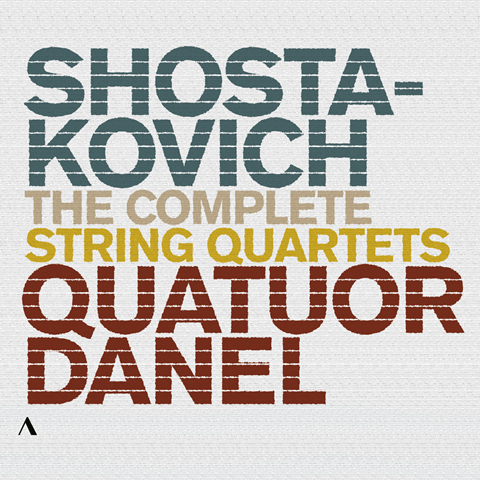A powerful new live cycle from these Shostakovich veterans

THE STRAD RECOMMENDS
The Strad Issue: June 2024
Description: A powerful new live cycle from these Shostakovich veterans
Musicians: Quatuor Danel
Works: Shostakovich: String Quartets nos.1–15, Two Pieces for String Quartet; Quartet Movement
Catalogue number: ACCENTUS ACC80585 (6 CDs)
Artistic endeavour never lies still. Nearly 20 years ago the Quatuor Danel made what is widely regarded as a benchmark recorded cycle of the complete Shostakovich quartets. But ideas evolve, and this latest set sees two new members in the lower strings in a brilliantly vivid live recording given in the Mendelssohn Hall of the Leipzig Gewandhaus.
Traversing these works is a demanding process, reflecting Shostakovich’s own trials and tribulations. Spanning 36 years, their stylistic and harmonic journey is perceptively interpreted here. The innocence of the lyrical C major First Quartet forms a savage contrast to the death knell of the Fifteenth Quartet, where the life blood drains away. In between, we have a vivid range of emotions, mainly hovering around darker hues. Small wonder, then, that Shostakovich’s compositions had been proscribed by Stalin. Having survived a brutal world war, endured Leningrad in the terrible siege; and worried through endless political intrigues, Shostakovich generates the full depiction of anxiety by leaning on the interval of semitones to camouflage a sense of key. Metre is flexible, which also reflects unsettled sensations.
Shostakovich frequently alludes to Jewish folk music, its sense of suffering and layered meaning mirroring his own struggles. In the Fourth Quartet the players give the almost grotesque klezmer effects full sway in the work’s finale before allowing the music to melt into a ghostly close. The Danel brings a vast range of instrumental colour to Shostakovich’s sound world, using deep sonorous tones one minute and non-vibrato the next, while some of the notes are barely audible. It observes the letter and spirit of the score with laudable accuracy, and handles swift-changing tempos with absolute mastery.
Schooled and nurtured by both the Borodin and Beethoven quartets, the Danel has inherited their performing legacy yet adds its own voice. Its players also understand Shostakovich’s structures which, although cast in traditional forms of sonata, fugatos, Beethovenian motivic development and passacaglias, are at the same time free and exploratory. The new shakes hands with tradition, and the Danel is alert to this, its surgically precise textures allowing the listener to hear these ideas clearly. There are parts of the writing, such as in the opening movements of Quartets nos.8 and 15, where the influence of Renaissance music is clearly evident. Here, the Danel sculpts the sense of tension and resolution very effectively.
Concert review: Quatuor Danel (2020)
Concert review: Quatuor Danel (2019)
Read: Postcard from Dorset: Purbeck International Chamber Music Festival
As the cycle progresses, Shostakovich’s style becomes more probing. By the Twelfth Quartet, he is adopting 12-note melodies, though ones that still retain a semblance of tonality. Metre is now freer, and string techniques more textural, with frequent trills, glissandos, Bartókian pizzicatos and screaming dissonance with angular edgy chords: the Allegretto furioso second movement of the Tenth Quartet a good case in point. Here the Danel generates a visceral power with searingly strong bow strokes. Dynamics become extreme, nowhere more so than in the macabre Serenade of the Fifteenth Quartet, depicted here with razor-sharp intensity. Shostakovich is uncompromising, no longer needing to curry favour. The C major section of the Elegy (the first of the Two Pieces), embedded within an overall landscape of E flat minor, hails back to the First Quartet’s innocent lines, while allowing the later movements to outline a sense of finality. The journey is complete.
JOANNE TALBOT























































No comments yet